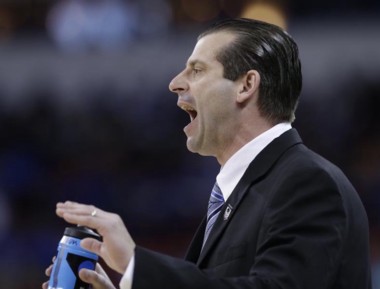T he University of Massachusetts recently announced a new contract extension for men’s basketball coach Derek Kellogg, who, with an annual salary of $994,500, is set to become the highest paid state employee in the Commonwealth.
The new contract comes immediately after the program’s most successful season in over a decade. The Minutemen were nationally ranked for much of the year, and made the NCAA “March Madness” Tournament for the first time since 1998. The deal extends Kellogg’s position through the 2018-2019 season, and replaces his previous contract, which had two years remaining. A native of Springfield, he played for Cathedral High School, then at UMass under John Calipari in the early 1990s, the glory days to which the state university’s most prominent athletic program has been trying to return ever since.
“I’m grateful to the university, and their commitment to the men’s basketball program,” Kellogg told the Advocate, adding that he believes his contract brings greater stability to the team, which will help keep it on the national scene.
“It’s tough to put a price tag on happiness,” continues Kellogg. “I’m ecstatic to be here, and I think the contract reflects that.”
Massachusetts now joins 40 other states whose highest paid public employee is a college coach, according to an article on Deadspin. Of those 40 employees, 27 are football coaches, 13 are basketball coaches (including University of Connecticut women’s basketball coach Geno Auriemma), and one (at the University of New Hampshire) is a hockey coach.
“He has built a solid foundation for the future,” UMass Athletic Director John McCutcheon said in a statement. “We felt it was appropriate to put something together that the university and he are both comfortable with in terms of the extension to keep him here for a long time.”
The new contract raises the inevitable question: are highly paid college coaches worth their salaries? Do they offer a return on investment?
Smith College economics professor Andrew Zimbalist isn’t certain that they are. Zimbalist specializes in the economics of sports, and has penned several books on the subject, including Unpaid Professionals: Commercialization and Conflict in Big-Time College Sports. While high-profile coaches have earned salaries comparable to other top-paid state employees for a long time, Zimbalist says, the disparity between the pay of coaches and others “is getting more exaggerated.”
“There’s not a lot of evidence” the success enjoyed by a sports program benefits the university, Zimbalist adds, noting that any surplus generated by a college basketball program is “usually very modest at best.”
The top 30 men’s basketball programs in the country generate, on average, $10-$15 million in revenue a year, Zimbalist says. Second-tier programs produce an average of $5-$10 million a year.
Coaches at those top 30 programs, such as Duke University’s Mike Krzyzewski—who reportedly makes $9,682,032—earn salaries comparable to coaches in the National Basketball Association. But while the basketball program at Duke, or Louisville, or Kentucky (where John Calipari currently coaches) might bring in $12 million a year, says Zimbalist, the average annual revenue for an NBA franchise is $120 million.
This comparison, Zimbalist says, “suggests a significant disproportionality.”
It also speaks to the pressure universities face to keep up-and-coming coaches like Kellogg from leaving for greener pastures. UMass’ last coach, Travis Ford, was hired by Oklahoma State University after the Minutemen’s strong showing in the NIT tournament back in 2008. Kellogg told the Advocate he had been contacted by several schools this past off-season.
That’s simply part of the business of college basketball, Kellogg says, adding that his salary is still far less than other coaches, like Krzyzewski.
“Coaching is the one profession with the least job security,” UMass Assistant Athletic Director John Sinnet says.
UMass’ on-court success last season brought greater notoriety, but, Sinnet says, it’s tough to know exactly how much financial benefit the university received beyond the revenue streams that are directly linked to the team—things like ticket sales and corporate donations.
For fiscal year 2014, Sinnet says, ticket revenue for the men’s basketball program was $991,000, compared to its fiscal year 2011 total of $596,000. He adds that corporate donations for fiscal year 2015 are projected at $1.4 million, up from $580,000 in fiscal year 2012.
Kellogg has helped raise $14 million in private fundraising, Sinnet continues, $11 million of which is earmarked for construction of the men’s and women’s programs’ new $28.5 million Champions Center locker room and training facilities, currently under construction south of the Mullins Center.
“The new practice center will help with recruiting,” Kellogg says, adding that potential players often ask about on-campus facilities.
That would, of course, benefit the basketball program. But what about the greater institution of UMass? Zimbalist says there are three ways an athletic program can benefit its university. A surplus can pay for lesser-revenue sports like track and field and swimming. The exposure an athletic program brings can lead to an increase in applications. Its success can lead to increased donations.
“There is no clear evidence” of the last, Zimbalist says, because donations driven by athletic success are often offset by a decrease in donations elsewhere.
Lower-profile sports programs may benefit, but for any college basketball program, “it is hard to generate a surplus,” he says, even for nationally recognized teams.
An increase in applications usually occurs when a college “goes from obscurity to national prominence, like UMass did in the 1990s,” continues Zimbalist. But even then, the greater number of applications does not correspond to an increase in academic competitiveness.
“One could make a case, as much as I’m loathe to say it, that a Nick Saban [head football coach at the University of Alabama] is worth it,” Zimbalist says. “But most aren’t.”•



